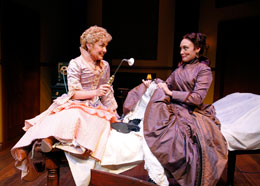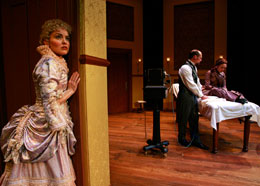
It’s the late 1800s and Sabrina Daldry is exhibiting symptoms that concern her considerably older husband. Light has been bothering Sabrina lately, and she cries at the drop of her heavily veiled hat. A consultation with a certain Dr. Givings reveals the cause of her ailments: hysteria. (A contemporary doctor would probably diagnose her condition as depression resulting from sexual frustration.) Fortunately, Dr. Givings has just the treatment to cure Sabrina of her ills, a device made possible by the recent arrival of electric current into New York’s wealthier homes. A two or three-minute application of this vibrating apparatus to Sabrina’s private parts, plus a bit of digital stimulation administered by the doctor’s faithful nurse Annie, provides an almost instantaneous improvement in Sabrina’s mental state (along with a number of moans and gasps of pleasure), and she eagerly agrees to return for daily treatments.
No, this is not the plot synopsis of a period porno, but rather the opening sequence of Sarah Ruhl’s delightful, provocative, conversation-provoking, and ultimately uplifting new comedy In The Next Room (or the vibrator play). Nominated for three Tony awards including Best Play last year, as well as for the Pulitzer Prize, In The Next Room now gets a Southern California premiere at South Coast Repertory to rival its Broadway debut. Directed with consummate finesse by Casey Stangl and performed by as perfect a cast as can be imagined, Ruhl’s latest matches her previous The Clean House and Dead Man’s Cell Phone for quirky originality and charm.
Meanwhile, in the next room, Dr. Givings’ wife Catherine is suffering from a post partum depression exacerbated by her inability to provide enough milk for her newborn. Mr. Daldry proposes that his African American housekeeper Elizabeth, who has recently lost an infant child, serve as the Givings child’s wet nurse, and though Catherine has misgivings about inviting a woman of color into her household, her husband reminds her that a Negro protestant would certainly be more acceptable than an Irish Catholic to feed the hungry infant.
Having another woman take over her maternal role only exacerbates Catherine’s depression, and when her curiosity at the sounds emanating from the next room gets the better of her, Catherine finds that a bit of under-the-undies vibration (administered first by an eager Sabrina and then by Catherine herself) is doing things to her that the good doctor has never been able to. Now, if she could only feels these same sensations in the bedroom…
21st Century audiences may chuckle at the innocence (or stupidity?) of a bygone era when even medical authorities saw no connection between sex and the “paroxysm” caused by this “electro-massage machine” (or “electric manipulator”), but titles like The Elusive Orgasm (on sale for $10.85 at Amazon.com) make it clear that there are Sabrinas and Catherines among us even today. (I’d like to be a fly on the wall as couples discuss Ruhl’s play on the way home from the theater.)
Performances at South Coast Rep simply could not be better.
Kathleen Early played a very different kind of sexually frustrated wife in The Neighborhood Playhouse’s production of Tennessee Williams’ Cat On A Hot Tin Roof. Her bubbly comedic work as Catherine reveals a whole new side to this talented, versatile actress, at the same time allowing us to glimpse the sadness lurking under Catherine’s perky surface. Chameleon-like Andrew Borba disappears into every role he plays, and his Dr. Givings is no exception, a stuffed-shirt with a potential for emotional growth and romantic, sexual passion. As Sabrina, Rebecca Mozo continues to prove herself one of L.A.’s very finest young stage actresses, revealing a saucy playfulness under her character’s figurative and literal corset. Tracey A. Leigh is a revelation as Elizabeth, as is her character, a fully-realized African American woman we haven’t seen on stage before. The always wonderful Libby West combines warmth and professional efficiency as Annie, and Tom Shelton too adds dimension to Mr. Daldry’s middle-aged pomposity. Finally, there’s the delightful work of Ron Menzel as a European-accented painter with his own issues with “hysteria,” easily solved by a special-for-males anal stimulator. (This may not be a play you’ll be comfortable taking your mother to.)
In The Next Room’s Broadway production scored a pair of Best Costume Design award nominations (the Tony and the Drama Desk), so it’s no wonder David Kay Mickelsen’s designs for SCR are spectacular period creations, particularly the women’s, which Ruhl’s plot exigencies allow us to see from their exquisitely detailed exteriors to the bustles and corsets hiding beneath. John Arnone’s excellent scenic design allows us to observe the goings and comings in both rooms, though there’s more of the latter to our right. Jim Ragland’s original music and sound design provide just the right mix of the whimsical and the romantic. Daniel Ionazzi’s lovely lighting design gives us rooms lit for the most part electrically and in one scene by candles. Philip D. Thompson is dialect coach, Jackie S. Hill production managers, and Kathryn Davies stage manager.
Earlier this year, Michael Vukadinovich’s Trog And Clay: An Imagined History Of The Electric Chair cast an absurdist eye on another historical phenomenon stemming from the arrival of electricity into our modern world, one coincidentally referred to several times in In The Next Room. Thanks to Sarah Ruhl, we now know that electrocution was not the only use for this revolutionary tool we now take for granted—except of course when the lights go out.
South Coast Repertory, 655 Town Center Drive, Costa Mesa.
www.scr.org
–Steven Stanley
October 3, 2010
Photos: Henry DiRocco/SCR






 Since 2007, Steven Stanley's StageSceneLA.com has spotlighted the best in Southern California theater via reviews, interviews, and its annual StageSceneLA Scenies.
Since 2007, Steven Stanley's StageSceneLA.com has spotlighted the best in Southern California theater via reviews, interviews, and its annual StageSceneLA Scenies.







 COPYRIGHT 2024 STEVEN STANLEY :: DESIGN BY
COPYRIGHT 2024 STEVEN STANLEY :: DESIGN BY